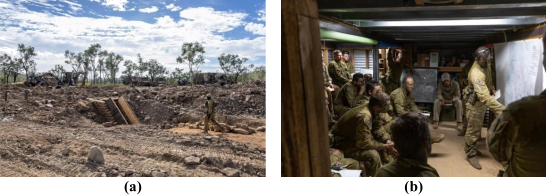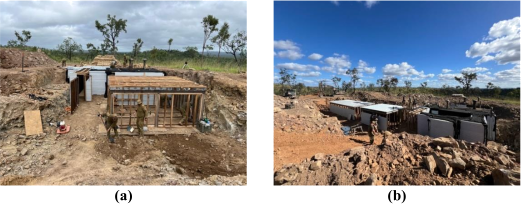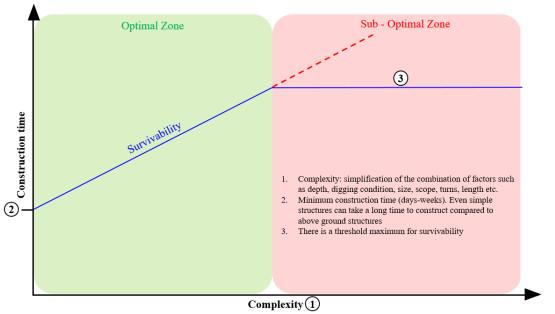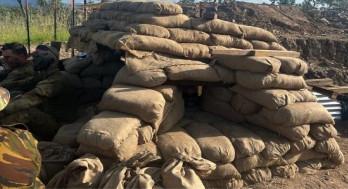The Command and Control (C2) nodes serve as a crucial ingredient to successful operation in an increasingly dynamic and complex battlespace. They are both physically and functionally essential in coordinating military operations, making them prime targets for adversaries. Despite technological advancements, the vulnerability of C2 nodes remains a challenge, requiring robust protection strategies. This article aims to provide all corps consideration for tactical protection of C2 nodes, drawing lessons from designing and constructing an underground brigade command post during Exercise Dingo Fury and Brolga Run 2024.
“Why an underground command post?"
Although being small and mobile increases survivability and flexibility of a C2 node, the tactical situation often requires occupation of static defensive positions. The recent conflict in Ukraine has further demonstrated the enduring relevance of trench warfare tactics to a stage where forces need to occupy defensive positions and soldiers have to dismount their armoured vehicles to clear enemy fortifications, trench by trench bunker by bunker. These events demonstrate the critical importance of being able to establish secure static positions that can withstand prolonged engagements and maintain operational effectiveness. “Is going deep always the answer?” No. “Do we need to know how to do so when required?” Absolutely. This article aims to provide four major factors that I would have considered more thoroughly if I were to do construct another underground command post: tactical positioning, functional layout, overhead-protection (OHP) and opportunities for deception.

Figure 1. (a) CP Earthworm getting backfilled with OHP, (b) K9 in CP Earthworm
Positioning
Positioning of a CP is critical for ensuring operational effectiveness and survivability of C2 nodes. Placing an underground CP on a forward slope enhances visibility and situational awareness, ideal for troop-level command posts needing direct oversight of operations but at the cost of increased vulnerability to enemy fire. Conversely, positioning on a reverse slope prioritizes concealment, reducing visibility to adversaries and minimizing the risk of direct fire, suitable for higher-level CPs such as battle group or brigade aiming to avoid detection. The condition of the ground also plays a significant part since difficulty of excavation or digging affects duration of construction, potentially exposing the construction activity to the enemy, which may reduce the survivability of the position itself. Ideally, an existing underground structure might be identified to be enhanced for use as a CP. Factors such as communication range, effective range of anticipated threats, and the balance between operational needs and risks guide these decisions, highlighting the complexity and importance of tailored positioning of underground C2 nodes, particularly given the effect of resources expended in their construction.

Figure 2. (a) Day 5 of construction, (b) Almost ready for backfill
Layout
The functional layout of a CP directly impacts the survivability of the occupants. A CP for a brigade can have a server room, sleeping quarters, operations room, admin bay and an ammunition bay. These must be strategically placed to optimise protection while maintaining operational efficiency. For instance, maximising dispersion of key elements such as the JOR and server room or increasing the number of turns in each hallway can enhance survivability by complicating enemy targeting but it extends construction time (which in turn increases the vulnerability) and reduces operational efficiency. There is no right or wrong answer however the design considerations of functional layout must align with the CP's purpose to balance the operational efficiency and survivability. Figure 3 demonstrates the relationship between the balancing factors.
Critically, this illustrates the Sub-Optimal Zone where additional complexity increases construction time without achieving any practical benefit in survivability. A CP would fall in this zone if, for example, its depth of overhead protection exceeded the requirements for medium-calibre artillery but was still insufficient to protect against heavy- calibre artillery or rockets. In this example, the added overhead would have increased construction time, but without providing any added practical benefit. Similarly, if a hypothetical CP was built from reinforced concrete sufficient to protect against the heaviest calibre fires but the enemy only fielded light or medium fires. In this case, the additional effort despite providing exceptional protection is of little practical benefit and represents a sub-optimal allocation of construction effort.

Figure 3. Design factors for underground command posts
Overhead Protection (OHP)
When it comes to defensive operations, the term overhead protection (OHP) is regularly used; however, it is often misunderstood in its application. According to Chapter 6.2 of LWP-G 3-6-4 Physical Protection, OHP primarily shields against "shell splinters," with 500 mm of earth offering reasonable protection. For protection against direct strikes, the OHP must be constructed in functional layers which includes multiple layers of uncompacted dirt, aggregates and timber depending on the availability of material and the type of anticipated threat (direct strike shattering effect vs splinters vs blast overpressure). While the doctrine does not define what “reasonable protection” means, 500 mm may protect occupants from splinters and fragmentation. Functional layers may provide an increased level of protection against blast overpressure as it absorbs the pressure through the voids. It should be noted that the design of functional layers requires a technical engineer to review the penetration depth, the covering material required and the structural integrity of the supporting structure. Balancing operational risk, time, and resources is crucial in OHP design and supporting structures. It's essential to acknowledge that no OHP can withstand every weapon system; thus, additional measures like deception, camouflage, and concealment remain critical. Ultimately, commanders must understand the level of overhead protection and what effect it provides when assessing risk to force in order to determine the most appropriate passive force protection measures and force posture to implement.

Figure 4. Firing point with sandbags used as OHP
Deception
Recent briefs from No.460 Sqn, RAAF highlighted the technological advancement in target acquisition and collection of intelligence. Adversaries can easily identify the construction methodology, material used, layout and other key intelligence to enable a direct hit with the right weapon system. A large-scale C2 node such as an underground CP will simply be impossible to conceal completely. So what? Either accept this or partially conceal and deceive the enemy on the purpose of the facility. Fresh vegetation should be re-applied as soon as construction is complete and light discharge should be mitigated. Deception can be achieved through concurrent construction activities with deliberate exposure of construction materials/machinery at a dummy position, placement of ventilation outlets and communication conduits at an off-set location to mislead adversaries. Once occupied deception can be supported by other passive measure such as remoting antennas and satellites away from the CP and reducing vehicles parked in vicinity of the CP. The aggregate of multiple small deception measures can be enough to change an adversary’s decision calculus.
Conclusion
Protection of C2 nodes is essential in where the principles of the defence, in particular trench warfare, remain relevant. The responsibility extends beyond RAE. Balancing resource constraints, tactical considerations, communications and IT systems, and operational needs is critical in developing effective protection strategies of static C2 nodes. There is no singular solution; rather, success lies in adaptable approaches that align with operational context and availability of time, space and resources.
LT Ji-Sang Yu
Construction Troop Commander, 3 CER









